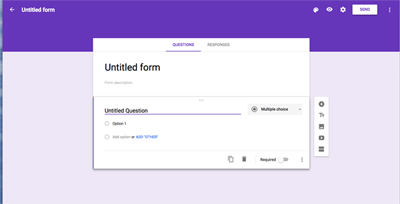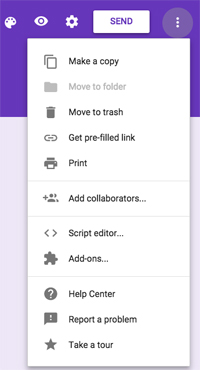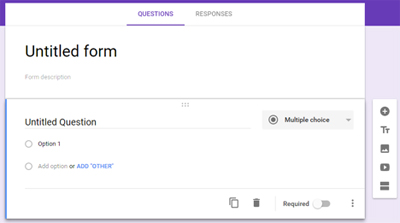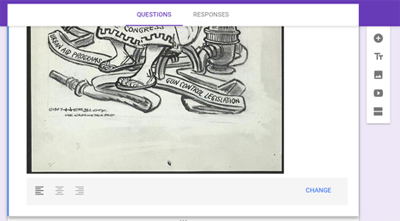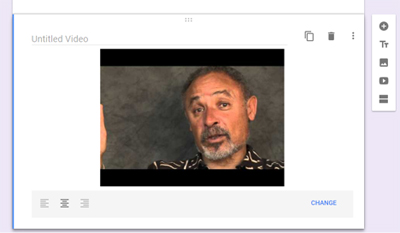Tech Tool: Creating a Google Form for Primary Source Analysis
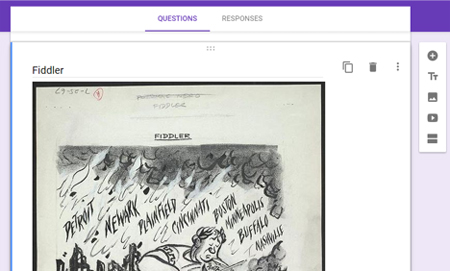
This is a guest post from Kelly Grotrian, an American History teacher at East Brunswick High School in East Brunswick, New Jersey.
Google Forms is a great tool to use for student primary source analysis because it provides a single point of access for multiple sources and efficiently collates student responses into a spreadsheet which you can use to evaluate work and inform your instruction.
Here is how to start using Google Forms (new version) with a primary source analysis activity.
Step 1
In your Google Drive, on the left-hand side of the screen select the red “New” button → More → Google Forms (you will see a purple icon).Step 2
You now have a blank form. Replace the Untitled Form title in the upper left-hand corner with the title of the primary source analysis activity; click in the Untitled form in the center section and the new title will appear.Form Icons: top right
The paint palette icon allows you to change the color and background of the form. You can change the color, select from a variety of backgrounds, or add your own image. For a primary source analysis activity, you may want to stick with a color rather than an image since you will be adding primary source images within the form.
The eyeball icon is the Preview button; click this button to view the form the way your students will see it. A new window will open each time you click this Preview button.
The gear or tool icon gives you options for adjusting various form settings. Here you can control who can complete or view the form, whether you want to collect “username” data, how many submissions you’d like to allow your students to complete, as well as what text you’d like to appear on the confirmation page once the form has been submitted. I recommend completing a test form first, then be sure to check all settings before sending the form to students.
The “Send” button allows you to share the form with students or other collaborators. If you’d like another teacher or staff member to view the form as you see it (and not to complete the form), simply select “Add Collaborators”. In order to share with students, you can either email the form or send a link to the form. I frequently post the links to forms I create on my website.
Finally, the three dots icon gives you several more options, including using Add-ons. One Add-on I like is “Form Publisher”, which outputs the form data into a clear format.
Step 3
You’re ready to start building your form! For my activity on race riots during the 1960s, I used a variety of resources from the Library of Congress. Here is how you can embed the material into your Google Form.Give your form a title (see step 2) and that new title will appear in place of “Untitled form”. You will see that the first question spot has already been added for you. Simply replace “Untitled Question” with your text. Responses options are multiple choice, checkboxes, drop down menu, short answer, paragraph, linear scale, multiple choice grid, date or time. Use the “paragraph” option for any response that is likely to be longer than three or four words.
In order to add another question, you need to select the plus-sign found on the right-hand side of the form. Here you can also opt to add a title and description, embed an image, upload a YouTube video, or add a section to divide your form into smaller, more manageable parts.
As you can see in the image at the top of this post, I added a political cartoon by Herb Block entitled “Fiddler” that I found on the Library of Congress resources. Images can be uploaded from your desktop/computer or via the Internet by using the website URL.
Another great option is that you can resize the image as necessary by clicking on the image itself and dragging the corners. You can also decide how you want to center the image by using the options underneath the image, as seen below.
If you’d like to add a video, the Library of Congress has a YouTube channel, which works really nicely with Google Forms. I wanted my students to hear a firsthand account of what happened in Newark, NJ during the summer of 1967 so I selected the oral history you see below.
You can adjust the size of the video by clicking and dragging just like you do with an image. You’ll notice that I centered the image of the video and have left the video slightly smaller. Try to make the video as large as possible to make it easier to see!
Google Form Tips
- You can embed a link by using the “help text” in a question format, which will open a new window for students to view the material. When I wanted students to view a map of Newark from the Library of Congress, I embedded the link to the map in the “help text” of the question I had asked. Remember, when using this option the link will always open in a new window/tab.
- If you’re going to make a long Google Form, I suggest using the “Sections” option as I did. In this way, students will only see a portion of the form which they must complete until they go on to the next section by clicking “Next”.
- Unlike Google Docs, Google Forms does not save automatically. You can opt to have students complete the Form in multiple parts, but they must select “Submit” at the end in order for the data to be saved .
- Finally, I mentioned the Add-on “Form Pubilsher” before. This Add-on allows you to view student responses in a much more manageable way. Another option I have also used is the Add-on “Save as Doc”, which allows you to take the data from the spreadsheet and put this into a Google Doc for easy reading!
More from Kelly Grotrian
- Integrating Tech: Primary Source Analysis using Google Forms
- How to use video and Google Forms to encourage deeper learning eSchool News October 20, 2015
- Twitter: @KEGrotrian

